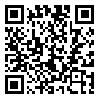BibTeX | RIS | EndNote | Medlars | ProCite | Reference Manager | RefWorks
Send citation to:
URL: http://sjsph.tums.ac.ir/article-1-5382-en.html
2- MD. Assistant Professor, Department of Education and Promotion Health, Tehran University of Medical Sciences, Tehran, Iran
3- Ph.D. Professor, Department of Education and Promotion Health, Tehran University of Medical Sciences, Tehran, Iran
4- BSc. Deputy of Health, Mazandaran University of Medical Sciences, Mazandaran, Iran
Background and Aim: Thalassemia major (ThM) is one of the most common autosomal recessive genetic disorders in the world. Its prevention and control is a priority in the disease prevention programs in the Iranian health system. The ThM screening program (screening at the time of marriage) has been an important step in its prevention in Iran. This study aimed to evaluate this program.
Materials and Methods: This was a descriptive-analytical study in Babosar District consisting of two phases. The first phase was a retrospective descriptive study aiming at finding the background causes of the diseases in subjects under 18 years old (born after March 1997). In phase 2, then, in an interventional analytical study, screening was repeated along with laboratory tests before, or at the beginning of, pregnancy (n = 5500).
Results: Phase 1(cross-sectional descriptive): There were 25 cases of ThM under 18 years old, parents of 15 of whom (60%) had married before 1997 and 4 (16%) had children suffering from ThM (S2). The parents of the remaining 10 (40%) had married after 1997 (S1). Phase 2: Considering the findings of Phase1, an interventional program called thalassemia screening was started in September 2006 including 9750 pregnant or pre-pregnanct mothers. The program led to identifying 20 new beta-thalassemia-carrier couples, including 10 couples married before 1997 and 10 married after 1997 (without official marriage registration, laboratory errors and hemoglobinopathies). All the 20 couples were quickly referred to the Genetic Center, which resulted in prevention of the birth of 4 ThM neonates.
Conclusion: The 9-year intervention (2006-2015) resulted in timely action, preventing birth of 4 thalassemia major babies. Considering incidence of the disease during the previous 9 years (1997-2006), it can be concluded that the before-after randomized clinical trial is an effective way to reduce thalassemia major incidence.
Received: 2016/09/19 | Accepted: 2016/09/19 | Published: 2016/09/19
| Rights and permissions | |
 |
This work is licensed under a Creative Commons Attribution-NonCommercial 4.0 International License. |





